Ariel Gordon's Blog, page 49
June 23, 2013
baby teeth
Published on June 23, 2013 20:39
wet cluster
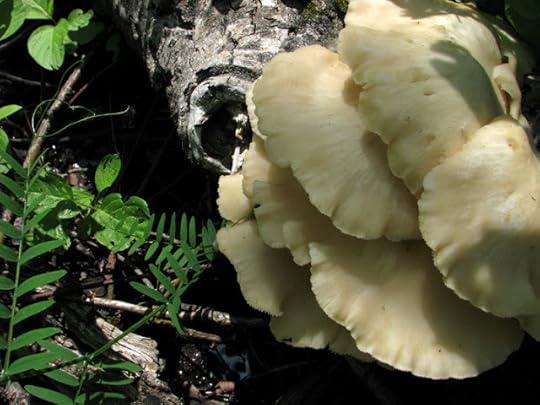 All photos Assiniboine Forest, Winnipeg, MB. June 22, 2013.
All photos Assiniboine Forest, Winnipeg, MB. June 22, 2013.* * *
M was working Saturday afternoon, so I hauled the girl to the forest. And it was steamy hot and buggy under the trees, which felt strange for us, after a loooong cool spring.
We'd brought along just-in-case bug spray and had to use it twice. Even so, the girl had to march up and down the path when I wanted to stop and take a picture so she wouldn't be swarmed.
It was a good session for oyster mushrooms. I saw four wet clusters as we walked and then the girl and I traded sightings: she saw the hatful of stinkhorns past-their-prime (i.e. flaccid and stinky) and I saw the tips of the mushrooms that look like teeth emerging from the ground.
And there were heaps of warty old toadstools to the side of the path which I didn't bother shooting.
Normally, I only do the everyday loop with the girl, but, somehow, I didn't feel finished, so I hauled her around the pond too. And we saw enormous black tadpoles swimming in the shallows as a goddamn reward.
And then we ran home and showered away the sweat and the bug spray and laid naked under the ceiling fan and read our books until M got home.
Published on June 23, 2013 20:28
June 22, 2013
swag grab bag
I know I usually post piles of books, both new and new-to-me.
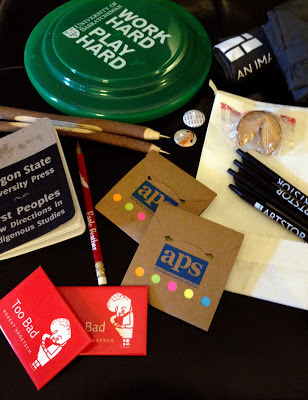 But after I unpacked my suitcase and various satchels from UMP-related travel to Victoria (for the Congress of the Humanities) and Saskatoon (for NAISA), after I'd sorted the books I'd picked up into to-read-immediately and to-read-later piles, I was left with this pile of swag.
But after I unpacked my suitcase and various satchels from UMP-related travel to Victoria (for the Congress of the Humanities) and Saskatoon (for NAISA), after I'd sorted the books I'd picked up into to-read-immediately and to-read-later piles, I was left with this pile of swag.
Swag is the branded stuff that organizations hand out as prizes or at conferences.
I'm not sure what it says about me that neither of two organizations where I've spent the bulk of my communications/administrative day-jobbery could afford good swag.
A paper gift bag or a fistfull of pens (made out of corn!) was about as far as either organization can/could legitimately stretch itself.
And, really, most swag is useless. Weird non-BPA-free plastic waterbottles. Strangely lightweight carabiners. Cheap hats.

But publisher swag is in a category all of its own.
I mean, how can you go wrong with pens, book bags, and post-it flag thingies?
(I'm still sort of in awe/skeptical of the UTP fortune cookie...)
I'll have you know that I wasn't a bookfair vulture, which is to say that I didn't swoop down and devour all the swag of the other exhibitors.
My favourites are the pins.
Though I'm not much of a pin-wearer, I could wear the Robert Kroetsch Too Bad cover and Marita Dachsel "Wife" poem pin all day.
(Sourced from the respective booths of the University of Alberta Press and Anvil Press...)
One day, I'm hoping to talk UMP into post-it flag thingies. Or maybe even a black woolen hat with UMP in white on the front...
 But after I unpacked my suitcase and various satchels from UMP-related travel to Victoria (for the Congress of the Humanities) and Saskatoon (for NAISA), after I'd sorted the books I'd picked up into to-read-immediately and to-read-later piles, I was left with this pile of swag.
But after I unpacked my suitcase and various satchels from UMP-related travel to Victoria (for the Congress of the Humanities) and Saskatoon (for NAISA), after I'd sorted the books I'd picked up into to-read-immediately and to-read-later piles, I was left with this pile of swag.Swag is the branded stuff that organizations hand out as prizes or at conferences.
I'm not sure what it says about me that neither of two organizations where I've spent the bulk of my communications/administrative day-jobbery could afford good swag.
A paper gift bag or a fistfull of pens (made out of corn!) was about as far as either organization can/could legitimately stretch itself.
And, really, most swag is useless. Weird non-BPA-free plastic waterbottles. Strangely lightweight carabiners. Cheap hats.

But publisher swag is in a category all of its own.
I mean, how can you go wrong with pens, book bags, and post-it flag thingies?
(I'm still sort of in awe/skeptical of the UTP fortune cookie...)
I'll have you know that I wasn't a bookfair vulture, which is to say that I didn't swoop down and devour all the swag of the other exhibitors.
My favourites are the pins.
Though I'm not much of a pin-wearer, I could wear the Robert Kroetsch Too Bad cover and Marita Dachsel "Wife" poem pin all day.
(Sourced from the respective booths of the University of Alberta Press and Anvil Press...)
One day, I'm hoping to talk UMP into post-it flag thingies. Or maybe even a black woolen hat with UMP in white on the front...
Published on June 22, 2013 07:55
June 20, 2013
More exquisite corpse-ing
listen to ‘Why you're so angry ’ on Audioboo
* * *
Here are parts three and four of my u/distopian exquisite corpse with Darryl Joel Berger.
He's so angry. (His character called mine a "spazatron"!)
* * *
Here are parts three and four of my u/distopian exquisite corpse with Darryl Joel Berger.
He's so angry. (His character called mine a "spazatron"!)
Published on June 20, 2013 11:21
June 19, 2013
Spring, elsewhere...

* * *
(clockwise from top left): Poet Bren Simmers on the beach near the main entrance to Vancouver's Pacific Spirit Regional Park; shed crab shells from our short spurt of beachcombing there; how I spent a couple of hours in Saskatoon - and I'd heartily recommend Luanne Armstrong's The Light Through the Trees: Reflections on Land and Farming; the view from the driveway at Dee Hobsbawn-Smith's farm after two wet years; the books I brought back from my travels, some bought at Congress, some won from the BC Book Prizes folk.
* * *
I know I've posted lots of pics focused on the events I did on my mini-tour, but here are some of the play moments.
Published on June 19, 2013 12:03
Call/response in Van
So I've been chatting with Bren Simmers and Anna Swanson for years, separately and together.
Our conversation started back in 2003 at Sage Hill, where I met Bren Simmers (and, also, Brenda Schmidt). We were both young ambitious poets. And that was about all you could say about us.
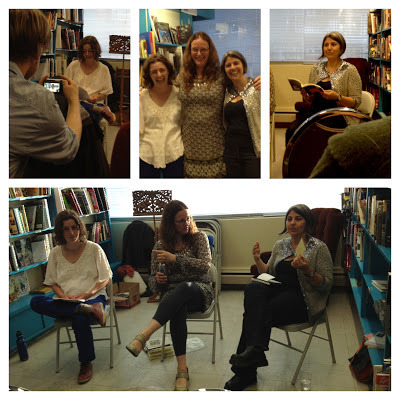 I met Anna Swanson (and, also, Gilly Wigmore) at the Banff Center a few years later.
I met Anna Swanson (and, also, Gilly Wigmore) at the Banff Center a few years later.
We were the youngest poets in the Wired Writing Studio program that fall. And we gravitated towards each other other because of that, but, also, because we recognized each other.
Bren and Anna knew each other from BC's community of young queer poets. And they'd both spent time at firetowers in Alberta, writing and watching for smoke.
And we all happened to publish our first books in 2010. But we'd never been in the same room together, Anna, Bren and I.
Coming to Vancouver for a few days between my conference in Victoria and my conference in Saskatoon just felt right. I hadn't been to Van in years. And what better excuse to coerce your kind peers, your whipsmart sympathetic community, to read with you than a new chapbook?
We decided to do a call & response, reading-in-the-round kind of thing. Which meant a somewhat elaborate structure, where we introduced each other and then read poems one after another, poems that responded to the previous poem in some way.
But it was so refreshing to move between poems, to find and follow the link between that poem and this poem, to listen in this slightly different way. (And one of Anna's poems made me tear up, which is always surprising and wonderful and also slightly offensive...I'm in control of what/who makes me cry, aren't I?)
After we'd gotten through the bits we'd planned, we got a bit theatre-sports-y, and asked the crowd to shout out themes/keywords/ideas. The idea was to pluck something out of the air and read a poem. And nothing was calling to me, so I read a poem that had been cut from How to Make a Collage for space considerations.
It's called "How to Keep a Relationship Fresh" but my private name for it is "the toenail poem." And it's the latest of the insulting love poems I've written to M. And both Anna and Bren had wanted me to read it when we were doing our scheming. So I did it.
Thanks to Bren and Anna for all their various hospitalities over the years, but, also, for their kindnesses this particular weekend.
(And thanks to Anna's mum, who wielded Anna's iPhone during the reading, for these pics...)
Our conversation started back in 2003 at Sage Hill, where I met Bren Simmers (and, also, Brenda Schmidt). We were both young ambitious poets. And that was about all you could say about us.
 I met Anna Swanson (and, also, Gilly Wigmore) at the Banff Center a few years later.
I met Anna Swanson (and, also, Gilly Wigmore) at the Banff Center a few years later.We were the youngest poets in the Wired Writing Studio program that fall. And we gravitated towards each other other because of that, but, also, because we recognized each other.
Bren and Anna knew each other from BC's community of young queer poets. And they'd both spent time at firetowers in Alberta, writing and watching for smoke.
And we all happened to publish our first books in 2010. But we'd never been in the same room together, Anna, Bren and I.
Coming to Vancouver for a few days between my conference in Victoria and my conference in Saskatoon just felt right. I hadn't been to Van in years. And what better excuse to coerce your kind peers, your whipsmart sympathetic community, to read with you than a new chapbook?
We decided to do a call & response, reading-in-the-round kind of thing. Which meant a somewhat elaborate structure, where we introduced each other and then read poems one after another, poems that responded to the previous poem in some way.
But it was so refreshing to move between poems, to find and follow the link between that poem and this poem, to listen in this slightly different way. (And one of Anna's poems made me tear up, which is always surprising and wonderful and also slightly offensive...I'm in control of what/who makes me cry, aren't I?)
After we'd gotten through the bits we'd planned, we got a bit theatre-sports-y, and asked the crowd to shout out themes/keywords/ideas. The idea was to pluck something out of the air and read a poem. And nothing was calling to me, so I read a poem that had been cut from How to Make a Collage for space considerations.
It's called "How to Keep a Relationship Fresh" but my private name for it is "the toenail poem." And it's the latest of the insulting love poems I've written to M. And both Anna and Bren had wanted me to read it when we were doing our scheming. So I did it.
Thanks to Bren and Anna for all their various hospitalities over the years, but, also, for their kindnesses this particular weekend.
(And thanks to Anna's mum, who wielded Anna's iPhone during the reading, for these pics...)
Published on June 19, 2013 07:53
June 17, 2013
Seafood + Victoria reading
I made two rookie mistakes during my Victoria reading.
First, I sat in the chair I'd been specifically warned off of. It was a slouchy leather armchair. It appealed to me because it looked comfortable and ALSO was right at the front, so I'd be able to get photos of the readers. (Oh, the ephemera...)
It was the kind of chair that absorbs you. That keeps you from EVER getting up.
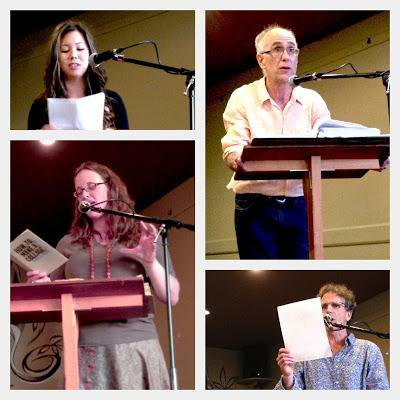 I perched on the edge of the chair during the open mic that preceded the main event. I sipped on my tea and watched Marita Dachsel do "Almera Woodward Johnson" from Glossolalia, trying not to blind her with my happiness at seeing her again.
I perched on the edge of the chair during the open mic that preceded the main event. I sipped on my tea and watched Marita Dachsel do "Almera Woodward Johnson" from Glossolalia, trying not to blind her with my happiness at seeing her again.
I sipped my tea while listening to Peter Midgley break out of his Congress acquisitions funk to read a poem. And I refrained from heckling him, which is about all that anyone can expect from me, in terms of behaviour. (I'm an inspired heckler...)
And then Yvonne Blomer, host of Planet Earth Poetry and Palimpsest pressmate, got up and introduced me. (She's a dab hand with a mic stand, that one...)
It was me and then three Malahat-ian readers: recent contributor/fictioneer Cody Klippenstein and board members Iain Higgins and Eric Miller.
And I lurched out of the chair. LURCHED!
My second rookie mistake was being somewhat under-rehearsed. Everything in How to Make a Collage is brand brand new, so I didn't yet have the poems half-memorized, as is my wont. And the sun was setting into the cafe. And I was tired after three days at Congress, all the exuberant shrubbery everywhere, the fact that there are no screens on the windows just getting to me.
But I'd eaten some magnificent seafood during those three days. And Congress is all about ideas and human conversation. And Susan Sanford Blades was kind enough to sell my books at the Malahat books table.
And it was so much fun. And I do so love reading, which is why I'd organized this mini-tour in the first place. So I launched in, reading poems from Hump and from How to Make a Collage. I read a poem for my aunt Sue, who lives in Victoria now, and who had snuck my cousin Chris into the event. I hadn't seen him in fifteen years. And I read for M, who was somewhere on the road between Winnipeg and Revelstoke, car-camping with the girl.
So I read for the people there, ones I knew and the ones I didn't, and felt that they were listening to me, that they were engaged with the poems, and then it was over.
First, I sat in the chair I'd been specifically warned off of. It was a slouchy leather armchair. It appealed to me because it looked comfortable and ALSO was right at the front, so I'd be able to get photos of the readers. (Oh, the ephemera...)
It was the kind of chair that absorbs you. That keeps you from EVER getting up.
 I perched on the edge of the chair during the open mic that preceded the main event. I sipped on my tea and watched Marita Dachsel do "Almera Woodward Johnson" from Glossolalia, trying not to blind her with my happiness at seeing her again.
I perched on the edge of the chair during the open mic that preceded the main event. I sipped on my tea and watched Marita Dachsel do "Almera Woodward Johnson" from Glossolalia, trying not to blind her with my happiness at seeing her again.I sipped my tea while listening to Peter Midgley break out of his Congress acquisitions funk to read a poem. And I refrained from heckling him, which is about all that anyone can expect from me, in terms of behaviour. (I'm an inspired heckler...)
And then Yvonne Blomer, host of Planet Earth Poetry and Palimpsest pressmate, got up and introduced me. (She's a dab hand with a mic stand, that one...)
It was me and then three Malahat-ian readers: recent contributor/fictioneer Cody Klippenstein and board members Iain Higgins and Eric Miller.
And I lurched out of the chair. LURCHED!
My second rookie mistake was being somewhat under-rehearsed. Everything in How to Make a Collage is brand brand new, so I didn't yet have the poems half-memorized, as is my wont. And the sun was setting into the cafe. And I was tired after three days at Congress, all the exuberant shrubbery everywhere, the fact that there are no screens on the windows just getting to me.
But I'd eaten some magnificent seafood during those three days. And Congress is all about ideas and human conversation. And Susan Sanford Blades was kind enough to sell my books at the Malahat books table.
And it was so much fun. And I do so love reading, which is why I'd organized this mini-tour in the first place. So I launched in, reading poems from Hump and from How to Make a Collage. I read a poem for my aunt Sue, who lives in Victoria now, and who had snuck my cousin Chris into the event. I hadn't seen him in fifteen years. And I read for M, who was somewhere on the road between Winnipeg and Revelstoke, car-camping with the girl.
So I read for the people there, ones I knew and the ones I didn't, and felt that they were listening to me, that they were engaged with the poems, and then it was over.
Published on June 17, 2013 08:19
June 3, 2013
Out-of-Town-Authors: Maleea Acker
Maleea Acker is a poet and environmental journalist based in Saanich, BC.
Her debut collection, The Reflecting Pool, was published by Pedlar Press in 2009. In poems that are canny mash-ups of city/travel/nature poetry (my favourite!), Acker touches down in urban Mexico, semi-urban Spain and rural Saskatchewan.
Her latest book is Gardens Aflame (New Star Books, 2012), an investigation of the Garry oak meadows on Vancouver Island. It is an exploration of a particular and preferred environment. It is a meditation on the garden, on cultivation versus conservation, on one's home place.
Next up for Acker is another poetry collection, Air-Proof Green, due out in fall 2013.
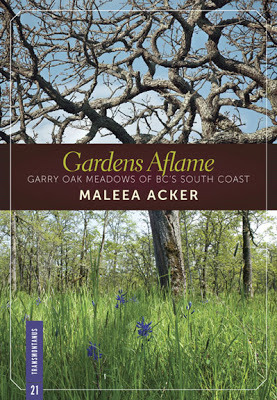 * * *
* * *
1) What do you want people to know about Gardens Aflame?
The book is the first, that I know of, that's taking a lot of the research of local scientists about Garry oak meadows (an ecosystem that only appears, in Canada, on the southern tip of Vancouver Island) and presenting it to a lay audience, albeit a very knowledgable lay audience. I tried to make it into a balanced combination of aesthetics, philosophy and science, going into the historical use of the meadows, the reasons they're important and some of the conservation and restoration work being done around the region.
Really, I just want people to read it and understand their key role in protecting the remaining tracts of the ecosystem. I've seen this island change so much since my childhood; so much of the wild land is now gone. We're going to have to alter our way of thinking and our expectations and our focus in order to protect and steward what's left. In that way, I think it is a book relevant to an audience outside of BC – the ideas contained within could just as easily apply to short grass and tall grass prairie ecosystems, to the Boreal forest or to coastal Douglas-fir forests.
2) Have you ever been to Winnipeg? What have you heard? (Winnipeggers know all about Vancouver Island. Our rich people wind up there and send chirpy emails about their tulips. In February.)
It's funny you ask. One half of my family goes back three generations in Winnipeg. My mother was born and raised on Oxford Street, in River Heights; my great grandparents lost all their money in the crash and had to sell their home on Wellington Crescent. Before my grandmother and uncle died, I used to spend time there almost every year, when we'd visit them on Oxford (my uncle had schizophrenia and lived with his mother his whole life) or up on Lake Winnipeg, just outside of Gimli, where they had a small cottage. I love it there. I was amazed at the winter cold, yes, but also the warm nights in summer; the giant elms, the way women carry their party shoes and put them on at the door of someone's house, the arts scene, and the history, in particular, of the north end, since the other side of my family are eastern European jews (who settled in the US). The only novel I've ever tried to write takes place partly in Winnipeg.
3) As a writer (i.e. someone whose artistic practice is predicated on time spent alone) how do you approach performance? What do you get out of it?
I actually enjoy performance of my work, though my nerves sometimes make the hour before highly entertaining, let's say. I find that for poetry, it's a good way to see which poems grab people and which don't. Some are made for the page, for individual reading; some translate far more readily to orality. I also like the community that forms during a reading, and the unlikeliness of people still attending a reading in our age of technological and social distractions. If I wasn't an introvert and so shy as a child, I might have ended up trying to work in performance – music, theatre, who knows...
4) Tell me about the differences between writing ecopoetry and writing environmental journalism (or environmental creative non-fiction)...
All three strike me as quite different in the manner in which they approach their subject. That is, though you can have an emotional or philosophical stance or belief in poetry, it's a very delicate matter to negotiate. Poetry and its subjects need a sidelong glance. Unless one is a terribly skilled writer (like Jack Gilbert, for instance), it's difficult not to wither your subject if you approach in direct light. In the journalism I've been writing, I have to be careful to maintain neutrality, but I can approach a subject head on. Craft in terms of sentence structure and so on is important; the techniques of poetry (music, tone, etc) aren't really appropriate for a pure journalism piece. Creative non-fiction may be a kind of sweet spot. I can use some of the techniques of poetry (image, metaphor, attention to the particular) but have more space in which to develop a story. The journalist truth still has to be told, but I can include my own views, my stance on a subject.
5) There are a pile of female BC poets who've worked on Alberta firetowers - the list also includes Anna Swanson, Bren Simmers, and Emelia Neilsen. How did spending summers in a remote firetower affect you?
It taught me how to see, how to listen, how to be alone. Those years are a wellspring I think I'll continue to benefit from for the rest of my life.
6) What are you reading right now? What are you writing right now?
I'm reading Lynn Coady's The Antagonist, which says something about how good her book is, as I am no longer a big novel reader. I'm also reading a lot about, (to borrow or steal Tim Lilburn's idea), how to live in the world as if it were home. Essays on ecology by Stan Rowe; new ideas on environmental philosophy by Timothy Morton; The Ecology of Eden by Evan Eisenberg. Some of this is for a new book I'm beginning research on about invasive species across the country. And then the usual assortment of poetry and poetics – Dean Young and Matthew Zapruder are high on my list right now, and Zagajewski's essays in Another Beauty; Hass' new essays. I'm trying to walk alongside poetry, and write when it's around, but mostly, I've been in editing mode for my second book of poems, due out in August with Pedlar Press (Toronto).
Her debut collection, The Reflecting Pool, was published by Pedlar Press in 2009. In poems that are canny mash-ups of city/travel/nature poetry (my favourite!), Acker touches down in urban Mexico, semi-urban Spain and rural Saskatchewan.
Her latest book is Gardens Aflame (New Star Books, 2012), an investigation of the Garry oak meadows on Vancouver Island. It is an exploration of a particular and preferred environment. It is a meditation on the garden, on cultivation versus conservation, on one's home place.
Next up for Acker is another poetry collection, Air-Proof Green, due out in fall 2013.
 * * *
* * *1) What do you want people to know about Gardens Aflame?
The book is the first, that I know of, that's taking a lot of the research of local scientists about Garry oak meadows (an ecosystem that only appears, in Canada, on the southern tip of Vancouver Island) and presenting it to a lay audience, albeit a very knowledgable lay audience. I tried to make it into a balanced combination of aesthetics, philosophy and science, going into the historical use of the meadows, the reasons they're important and some of the conservation and restoration work being done around the region.
Really, I just want people to read it and understand their key role in protecting the remaining tracts of the ecosystem. I've seen this island change so much since my childhood; so much of the wild land is now gone. We're going to have to alter our way of thinking and our expectations and our focus in order to protect and steward what's left. In that way, I think it is a book relevant to an audience outside of BC – the ideas contained within could just as easily apply to short grass and tall grass prairie ecosystems, to the Boreal forest or to coastal Douglas-fir forests.
2) Have you ever been to Winnipeg? What have you heard? (Winnipeggers know all about Vancouver Island. Our rich people wind up there and send chirpy emails about their tulips. In February.)
It's funny you ask. One half of my family goes back three generations in Winnipeg. My mother was born and raised on Oxford Street, in River Heights; my great grandparents lost all their money in the crash and had to sell their home on Wellington Crescent. Before my grandmother and uncle died, I used to spend time there almost every year, when we'd visit them on Oxford (my uncle had schizophrenia and lived with his mother his whole life) or up on Lake Winnipeg, just outside of Gimli, where they had a small cottage. I love it there. I was amazed at the winter cold, yes, but also the warm nights in summer; the giant elms, the way women carry their party shoes and put them on at the door of someone's house, the arts scene, and the history, in particular, of the north end, since the other side of my family are eastern European jews (who settled in the US). The only novel I've ever tried to write takes place partly in Winnipeg.
3) As a writer (i.e. someone whose artistic practice is predicated on time spent alone) how do you approach performance? What do you get out of it?
I actually enjoy performance of my work, though my nerves sometimes make the hour before highly entertaining, let's say. I find that for poetry, it's a good way to see which poems grab people and which don't. Some are made for the page, for individual reading; some translate far more readily to orality. I also like the community that forms during a reading, and the unlikeliness of people still attending a reading in our age of technological and social distractions. If I wasn't an introvert and so shy as a child, I might have ended up trying to work in performance – music, theatre, who knows...
4) Tell me about the differences between writing ecopoetry and writing environmental journalism (or environmental creative non-fiction)...
All three strike me as quite different in the manner in which they approach their subject. That is, though you can have an emotional or philosophical stance or belief in poetry, it's a very delicate matter to negotiate. Poetry and its subjects need a sidelong glance. Unless one is a terribly skilled writer (like Jack Gilbert, for instance), it's difficult not to wither your subject if you approach in direct light. In the journalism I've been writing, I have to be careful to maintain neutrality, but I can approach a subject head on. Craft in terms of sentence structure and so on is important; the techniques of poetry (music, tone, etc) aren't really appropriate for a pure journalism piece. Creative non-fiction may be a kind of sweet spot. I can use some of the techniques of poetry (image, metaphor, attention to the particular) but have more space in which to develop a story. The journalist truth still has to be told, but I can include my own views, my stance on a subject.
5) There are a pile of female BC poets who've worked on Alberta firetowers - the list also includes Anna Swanson, Bren Simmers, and Emelia Neilsen. How did spending summers in a remote firetower affect you?
It taught me how to see, how to listen, how to be alone. Those years are a wellspring I think I'll continue to benefit from for the rest of my life.
6) What are you reading right now? What are you writing right now?
I'm reading Lynn Coady's The Antagonist, which says something about how good her book is, as I am no longer a big novel reader. I'm also reading a lot about, (to borrow or steal Tim Lilburn's idea), how to live in the world as if it were home. Essays on ecology by Stan Rowe; new ideas on environmental philosophy by Timothy Morton; The Ecology of Eden by Evan Eisenberg. Some of this is for a new book I'm beginning research on about invasive species across the country. And then the usual assortment of poetry and poetics – Dean Young and Matthew Zapruder are high on my list right now, and Zagajewski's essays in Another Beauty; Hass' new essays. I'm trying to walk alongside poetry, and write when it's around, but mostly, I've been in editing mode for my second book of poems, due out in August with Pedlar Press (Toronto).
Published on June 03, 2013 07:42
June 1, 2013
Ecological 'rewilding' a manly affair
Winnipeg Free Press - PRINT EDITION
Reviewed by Ariel Gordon
Feral: Rewilding the Land, the Sea and Human Life
By George Monbiot
Allen Lane, 336 pages, $30
Rabble-rousing U.K. journalist George Monbiot doesn't much like sheep.
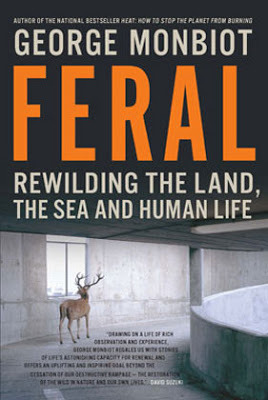 In his eighth book, Feral, he minces no words about the effect the ruminants have on the British landscape: "Sheep farming in this country is a slow-burning ecological disaster, which has done more damage to the living systems of this country than either climate change or industrial pollution."
In his eighth book, Feral, he minces no words about the effect the ruminants have on the British landscape: "Sheep farming in this country is a slow-burning ecological disaster, which has done more damage to the living systems of this country than either climate change or industrial pollution."
Monbiot worked as an investigative journalist in Brazil, Indonesia and East Africa for six years. He's been a columnist for The Guardian for nearly two decades, writing on multinational corporations (2000's The Captive State), democratic reform (2003's The Age of Consent) and climate change (2006's Heat).
.But it was a move to the Welsh countryside with his young family in 2007 that forced Monbiot to focus on his immediate surroundings: the heaths and moors of the Cambrian Mountains.
Even though his Guardian column demanded that he range across disciplines - from science to economics to politics - Monbiot realized he felt disengaged from his body and his environment. He was, as he called it, "ecologically bored."
After a little digging, Monbiot realized that the Welsh landscape was not especially natural. As little as 1,300 years ago, according to the fossil record, most of the U.K. was covered in forest. Man cut down the trees and then filled the empty spaces with sheep, who browse anything green down to the ground.
"Heather, which many nature-lovers in Britain cherish, is typical of the hardy, shrubby plants which colonize deforested land," writes Monbiot. "I do not see heather moor as an indicator of the health of the upland environment, as many do, but as a product of ecological destruction."
What follows is an argument for the "rewilding" of the British uplands so as to reverse some of the environmental damage they've sustained and re-invigorate the people who live there.
Rewilding, according to Monbiot, "involves reintroducing absent plants and animals (and in a few cases culling exotic species which cannot be contained by native wildlife), pulling down the fences, blocking the drainage ditches, but otherwise stepping back." Monbiot advocates rewilding only in areas "in which production is so low that farming continues only as a result of the taxpayer's generosity."
Readers may be wondering how Monbiot's ideas apply to the North American landscape. While we don't have sheep, we do have cattle ranches and a high density of deer in both rural and urban areas. And scientists and conservation officers across the country are currently asking some of the same questions Monbiot does on the value of maintaining (and in some cases reintroducing) keystone species such as beavers and wolves.
Unfortunately, Monbiot sandwiches his largely compelling arguments between chapters that detail his goal to live a life "richer in adventure and surprise." (In Monbiot's case that mostly seems to mean the times he nearly kills himself with his sea kayak.)
In addition, while Monbiot was likely motivated by beginning a family to write Feral, there is no denying that the risk-taking he describes is gendered. It is predicated on the fact that there is someone at home with the children who is not trying to kill herself with a sea kayak.
Combine those interludes with Monbiot's nostalgic recollections of his adventures in East Africa and Brazil and, well, you've got a very manly book.
Part of the posturing is probably due to the fact that Monbiot is a ‘radical thinker’ and not a lowly scientist or an academic. These stories are meant, at least in part, to establish Monbiot’s bona fides.
They’re also likely an attempt to inject some colour into a book where he mostly wanders through the woods, muttering bleakly about sheep.
Ariel Gordon is a Winnipeg writer.
Reviewed by Ariel Gordon
Feral: Rewilding the Land, the Sea and Human Life
By George Monbiot
Allen Lane, 336 pages, $30
Rabble-rousing U.K. journalist George Monbiot doesn't much like sheep.
 In his eighth book, Feral, he minces no words about the effect the ruminants have on the British landscape: "Sheep farming in this country is a slow-burning ecological disaster, which has done more damage to the living systems of this country than either climate change or industrial pollution."
In his eighth book, Feral, he minces no words about the effect the ruminants have on the British landscape: "Sheep farming in this country is a slow-burning ecological disaster, which has done more damage to the living systems of this country than either climate change or industrial pollution."Monbiot worked as an investigative journalist in Brazil, Indonesia and East Africa for six years. He's been a columnist for The Guardian for nearly two decades, writing on multinational corporations (2000's The Captive State), democratic reform (2003's The Age of Consent) and climate change (2006's Heat).
.But it was a move to the Welsh countryside with his young family in 2007 that forced Monbiot to focus on his immediate surroundings: the heaths and moors of the Cambrian Mountains.
Even though his Guardian column demanded that he range across disciplines - from science to economics to politics - Monbiot realized he felt disengaged from his body and his environment. He was, as he called it, "ecologically bored."
After a little digging, Monbiot realized that the Welsh landscape was not especially natural. As little as 1,300 years ago, according to the fossil record, most of the U.K. was covered in forest. Man cut down the trees and then filled the empty spaces with sheep, who browse anything green down to the ground.
"Heather, which many nature-lovers in Britain cherish, is typical of the hardy, shrubby plants which colonize deforested land," writes Monbiot. "I do not see heather moor as an indicator of the health of the upland environment, as many do, but as a product of ecological destruction."
What follows is an argument for the "rewilding" of the British uplands so as to reverse some of the environmental damage they've sustained and re-invigorate the people who live there.
Rewilding, according to Monbiot, "involves reintroducing absent plants and animals (and in a few cases culling exotic species which cannot be contained by native wildlife), pulling down the fences, blocking the drainage ditches, but otherwise stepping back." Monbiot advocates rewilding only in areas "in which production is so low that farming continues only as a result of the taxpayer's generosity."
Readers may be wondering how Monbiot's ideas apply to the North American landscape. While we don't have sheep, we do have cattle ranches and a high density of deer in both rural and urban areas. And scientists and conservation officers across the country are currently asking some of the same questions Monbiot does on the value of maintaining (and in some cases reintroducing) keystone species such as beavers and wolves.
Unfortunately, Monbiot sandwiches his largely compelling arguments between chapters that detail his goal to live a life "richer in adventure and surprise." (In Monbiot's case that mostly seems to mean the times he nearly kills himself with his sea kayak.)
In addition, while Monbiot was likely motivated by beginning a family to write Feral, there is no denying that the risk-taking he describes is gendered. It is predicated on the fact that there is someone at home with the children who is not trying to kill herself with a sea kayak.
Combine those interludes with Monbiot's nostalgic recollections of his adventures in East Africa and Brazil and, well, you've got a very manly book.
Part of the posturing is probably due to the fact that Monbiot is a ‘radical thinker’ and not a lowly scientist or an academic. These stories are meant, at least in part, to establish Monbiot’s bona fides.
They’re also likely an attempt to inject some colour into a book where he mostly wanders through the woods, muttering bleakly about sheep.
Ariel Gordon is a Winnipeg writer.
Published on June 01, 2013 17:16
May 28, 2013
A week later
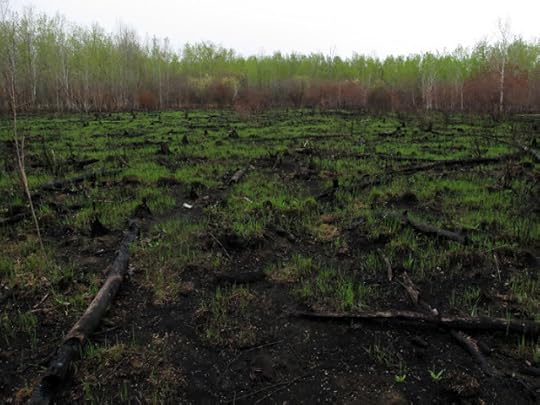
* * *
Photo from Assiniboine Forest, Winnipeg, MB. May 19, 2013.
* * *
I shot from this same POV on May 12. The snow had only just melted. As we trudged through the blackened field, all we could smell was smoke and charcoal.
It's hard to believe that anything will grow from ash...and so it was a relief to revisit the site a week later and to see all the green.
Published on May 28, 2013 21:51




